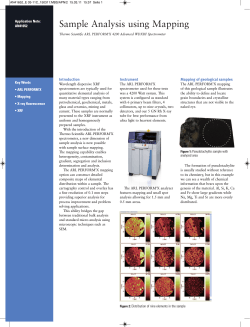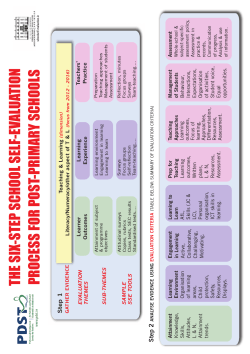
University Library Assessment Program
University Library Assessment Program March 24, 2015 Prepared by: Carisa Polischuk, Assessment Analyst University Library Assessment Program Background This paper outlines key elements of the University Library assessment program. This program was established within the context of the University Library Strategic Plan and the library’s commitment to evidence-based decision making. The assessment program is also linked to the University’s Framework for Assessment which has 3 broad purposes: quality improvement to bring performance and goals into closer alignment; quality assurance to periodically test performance against expectations; and accountability to ensure the regular communication of outcomes, desired outcomes, successes and failures. Since 2011, the University Library has made significant progress in the development of an assessment program. On May 11, 2011, an Assessment Analyst joined the library to assist with the development and implementation of a library-wide program of assessment. Organizational Structure The Dean oversees the University Library assessment program, including operational activities undertaken as part of the program, which is managed through the Dean’s Office. All major assessment projects require approval from the Dean. The Assessment Analyst provides expertise and assistance in collecting, analyzing, and managing operational statistical data, developing assessment instruments, conducting ad-hoc studies and assisting in assessing the quality and effectiveness of library operations. The Assessment Analyst plays a key role in validating statistics to ensure that data requests are responded to in an accurate and consistent manner. Periodically, the Assessment Analyst will also provide analyses on various library statistics to help inform evidence-based decision making. To date the program of assessment can be divided into the following elements: library data and statistics; library surveys; key performance indicators and benchmarking; and other assessment related activities. Library Data and Statistics Part of the assessment program at the University Library requires annual coordination and systematic reporting of library statistics for key external bodies both nationally (e.g. Canadian Association of Research Libraries – CARL) and internationally (e.g. Association of Research Libraries – ARL, Association of Academic Health Sciences Libraries – AAHSL). Typically, data submitted relating to collections and collections expenditures, salary expenditures, overall expenditures, and personnel and public services, is made available in the public domain through or by other agencies. Page 2 of 7 University Library Assessment Program Tracking Library Data • In order to submit library statistics, it is necessary for the Dean’s Office to track library holdings and public service statistics which are collected in each branch/unit • Public service statistics are used for ARL, CARL, and AAHSL statistics submissions • Library holdings statistics are used for ARL statistics submissions and for the University’s annual submission to the provincial government Statistics Submissions • Association of Research Libraries (ARL) Annual Statistics o Data submitted for the library overall and for Health Sciences and Law o Data submitted in the following areas: collections, expenditures, fringe benefits, expenditures from external sources, personnel, instruction, reference, circulation, use of electronic resources, interlibrary loans, doctor’s degrees and faculty, enrollment, and salary statistics • Canadian Association of Research Libraries (CARL) Annual Statistics o Data submitted for the library overall in the following areas: expenditures, establishment and collections; personnel; use, facilities, service; emerging trends and salary statistics • Association of Academic Health Sciences Libraries (AAHSL) Annual Statistics o Coordinated by Health Sciences (Dean’s Office provides expenditures and salaries & wages data) • ARL Facilities Inventory (due every 3 years) o Data submitted for assignable square footage of library space, physical locations, funds spent on renovations projects, and images demonstrating new and effective ways of using library spaces as a way of enhancing learning, teaching and research • Saskatchewan Universities Funding Mechanism (SUFM) Annual Submission o Data provided to the Office of Institutional Planning and Assessment (IPA) for the University’s SUFM submission to the provincial government o Data includes library holdings item counts and equivalent volume totals for the library overall (including each branch) and for University Archives • American Appraisal Canada Ltd. Annual Submission o Data provided regarding dollar value changes for Library Collections in three categories: print journals, print monographs, and aggregate total for microforms o Includes additions and deletions to collections and transfers in and out of new or existing collections Library Surveys Effective planning and coordination of library surveys is another element of the assessment program. This involves careful design and administration of surveys, appropriate analysis and interpretation of results, identification of recommendations and actions to be taken for quality Page 3 of 7 University Library Assessment Program improvement, and communication back to stakeholders. The Assessment Analyst is responsible for coordination, administration, and/or reporting out on the results of library surveys. Library surveys are divided into the following categories: major library surveys administered by the Dean’s Office that occur on a cyclical basis and involve a significant portion of the library user population (students, faculty, and staff); secondary library surveys that are cyclical or oneoff in nature and typically involve a smaller portion of the library user population (including surveys administered by the Dean’s Office or by library faculty/staff in consultation with the Assessment Analyst); surveys received from external organizations requiring an official response from the University Library. Major Library Surveys • LibQUAL+ (every 3 years since 2007) • Library Employee Opinion Survey (LEOS) (every year since 2006 with the exception of 2007) Secondary Library Surveys Recent examples include: • Librarians as Educators Survey (July 2014) • Library Leadership Development Program Surveys (2009-2011, 2013, 2014) • Library Orientation Survey (July 2014, December 2014 – ongoing administration 3-4 times per year) • Safe Study Survey (December 2013, April 2014) • Indigenous Voices Needs Assessment Survey (October 2014) • LS&IT Customer Satisfaction Survey (November 2014 – ongoing administration through random selection) • SHIRP Survey (June 2014) External Surveys Recent examples include: • Primary Research Group Inc. Survey on Academic Library Inter-Library Loan Practices (November 2013) • Association of College and Research Libraries (ACRL) Academic Library Trends/Professional Development Trends survey (April 2015) • ARL Budget Survey (November 2014) • SPEC Surveys (4 optional surveys scheduled for 2015) Performance Indicators and Benchmarking In order to gauge progress toward the University Library’s strategic goals, a significant element of the assessment program is the development of performance indicators to track progress over time and to benchmark progress against peer institutions (e.g. U15 group of Canadian research universities). The University Library has access to a wealth of data for the U of S and U15 peer institutions through our membership and participation in leading professional associations and Page 4 of 7 University Library Assessment Program consortia (especially ARL, CARL, and COPPUL). Data is also available through independent public reports such as Maclean’s annual rankings of Canadian universities. ARL Data • All data submitted annually to ARL is made available to all member institutions providing years of statistics for each institution • Allows for statistics to be summarized to determine trends overtime and to benchmark compared to other ARL institutions (e.g. U15) • ARL releases the Library Investment Index rankings annually o The index is calculated using 4 variables in the annual ARL statistics submission o All members have access to the Library Investment Index data from all ARL institutions therefore results can be summarized by institution and benchmarked against peer institutions AAHSL Data • All data submitted annually to AAHSL is made available to all member institutions providing years of statistics for each institution • Allows for statistics to be summarized to determine trends overtime and to benchmark compared to other AAHSL institutions including some U15 institutions CARL Data • All data submitted annually to CARL is made available to all member institutions providing years of statistics for each institution • Allows for statistics to be summarized to determine trends overtime and to benchmark compared to other CARL institutions (e.g. U15) • Council of Prairie and Pacific University Libraries (COPPUL) also publishes a report using CARL statistics • LibQUAL+ is coordinated through CARL o All institutions participating in LibQUAL+ receive their institutional data as well as access to the final reports from all other participating institutions o Data from peer institutions (e.g. U15) can be pulled from these final reports and compared to individual institutional data Employee Engagement / Job Satisfaction • The University Library monitors results from two major employee surveys: University Employee Opinion Survey (UEOS) and Library Employee Opinion Survey (LEOS) • Employee engagement results from UEOS forms part of our key performance indicators and our dashboard scorecard which is tracked annually for the University Library and the U of S overall. Values results derived from UEOS are also tracked internally to determine how well we are living our values within the library and compared to the U of S overall. Page 5 of 7 University Library Assessment Program • Results from LEOS provides the library with valuable information on 11 job satisfaction dimensions that informs our planning and our approach to transformative change. LEOS is also identified as one of our key performance indicators for employee engagement in the University Library Strategic Plan. Achievement Record / Supplement • The University Library Achievement Record is a means of reporting to the University community on key performance indicators in the University Library Strategic Plan in order to measure performance towards the University Library’s vision, mission and values • A full Achievement Record is released every 2 years (in years ending with an even number) with a more brief version (Achievement Record Supplement) released in between these years (in years ending with an odd number) Maclean’s Rankings • Maclean’s magazine releases its annual rankings of Canadian universities where the U of S is ranked in a group of 15 medical doctoral institutions defined as offering a broad range of PhD programs and research with all having medical schools (similar to the U15 group) • The rankings include 2 library indicators: library expenses measuring the percentage of the university’s budget dedicated to library funding overall and library acquisitions measuring the proportion of the library’s budget allocated to the acquisition of new material • Maclean’s data is drawn from publically available information and collated by the magazine Other Assessment Related Activities The University Library also undertakes other assessment related activities including peer and student evaluation of teaching, periodic internal reviews, and provision of data to colleges who have accreditation requirements with external accrediting agencies. Evaluation of Teaching • At the University Library, there is a systematic program of peer and student evaluation of librarian teaching which forms an essential component of tenure and promotion considerations for librarians for whom teaching is assigned Periodic Reviews • Periodically, the University Library undertakes reviews of branches, units, and functional areas as commissioned by the Dean. These reviews help to gauge quality and ensure alignment with University Library strategic goals. Page 6 of 7 University Library Assessment Program Accreditation Processes • Several of the professional colleges are accredited by external professional bodies and/or accrediting agencies and as required the University Library supports accreditation processes by providing data and statistics on library usage and collections to colleges for inclusion in their accreditation documentation • Any data and statistics supplied is generally co-ordinated and validated through the Assessment Analyst to help ensure a consistent and defined approach Summary The University Library assessment program is necessary to assess the quality and effectiveness of library operations and programs tied to quality improvement, quality assurance, and accountability. The assessment program is under ongoing development and it will continue to develop and evolve over time. A chart illustrating the University Library Assessment Program follows. Page 7 of 7 University Library Assessment Program Chart - March 2015 University of Saskatchewan Framework for Assessment (comprehensive assessment strategy) University Library Assessment Program (continuous improvement; evidence based decision making) Quality Improvement Accountability Quality Assurance (aligning goals and performance) (communicating outcomes, successes and failures) (testing performance against expectations) Activities Library Surveys • Major Library Surveys (e.g. LibQUAL+, Library Employee Opinion Survey) • Secondary Library Surveys (e.g. Librarians as Educators Survey, Library Leadership Development Program Surveys, Library Orientation Survey, Safe Study Survey, Indigenous Voices Needs Assessment Survey, LS&IT Customer Satisfaction Survey, SHIRP Survey) • External Surveys (e.g. Primary Research Group Inc. Survey on Academic Library Inter-Library Loan Practices, ACRL Professional Development Trends Survey; ARL Budget Survey, SPEC Surveys) Performance Indicators • Achievement Record and Supplement Evaluation of Teaching • Student and Peer Evaluation of Teaching Activities Library Statistics Submissions • ARL, CARL, and AAHSL Annual Statistics • ARL Facilities Inventory • SUFM Annual Submission • American Appraisal Canada Ltd. Annual Submission External Publications • ARL publications including Library Investment Index Rankings • AAHSL, CARL, and COPPUL (using CARL stats) Publications • Maclean's Annual University Rankings (including 2 library indicators) • University Employee Opinion Survey Internal Publications • Achievement Record and Supplement • Survey results (LibQUAL+, LEOS, etc.) Strategic Planning • University Library Strategic Plan Progress Report Activities Periodic Reviews (branch, unit, and functional area reviews) • External Review of Technical Services Activities in Services to Libraries • Law Library Review • Liaison Librarian Program Review • Organizational Review of University Archives and Special Collections • External Review of SHIRP
© Copyright 2025









